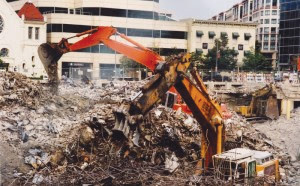

For decades, Californians faced a double injustice. The state's redevelopment agencies routinely used eminent domain to seize perfectly fine homes and businesses and transfer them to private developers. Billions of tax dollars would then flow into these developers'
ill-conceived schemes, schemes that often failed to meet expectations. The redevelopment agencies were responsible for at least 200 projects that used eminent domain for private gain.
Californians were rightly relieved when Gov. Jerry Brown dissolved the redevelopment agencies in 2012. But Assembly Bill 2, which Gov. Brown signed this September, brought redevelopment back with a vengeance.
The new agencies called, "Community Revitalization and Investment Authorities" (CRIAs), have the same powers to seize property as the old ones. But these new authorities
face even fewer restrictions on their use of eminent domain making them even more dangerous.
Before using eminent domain in redevelopment areas, the old agencies had to submit blight studies backed up by actual evidence. This system was prone to abuse, but it did provide some important protections to property owners.
Under AB 2, studies aren't required. To designate a redevelopment area an authority need only determine that the targeted area meets certain conditions.
80 percent or more of the land within a redevelopment area must meet two standards meaning that 20 percent of the land need not meet any standards at all:
First, the annual median household income must be less than 80 percent of the statewide annual median income. That is, AB 2 explicitly states that only poorer areas are subject to redevelopment.
Second, three of the following four conditions must be met:
Property owners should not lose their homes and businesses simply because they are less well off than other Californians. They should not lose what they've worked so hard to own because their governments fail to keep crime down and infrastructure up and running. California's property owners are being punished for things they are powerless to remedy.
Furthermore, the term "deteriorated" is undefined in the statute leaving it open to very broad interpretation. The previous redevelopment program proved that such vague terms are recipes for abuse.
No one, rich or poor, should have his/her home or business forcibly taken and transferred to a private developer. There's something particularly disgusting about well connected developers abusing the political process to steal from those with the fewest resources available to defend their property. Yet this is how eminent domain for private development usually works, as documented in IJ's report Victimizing the Vulnerable: The Demographics of Eminent Domain Abuse.
WHAT CAN BE DONE?
Because of AB 2, Californians are once again in danger of losing their land to taxpayer funded boondoggles. But the situation is not hopeless. Time and again, engaged citizens have triumphed over better connected, better funded opponents saving their homes and businesses.
Take Action: If you or your neighbors have been threatened with eminent domain, please contact us at activism@ij.org. You'll want to be on guard as soon as you hear about a redevelopment plan. Though they frequently say they don't want to use eminent domain, redevelopment authorities can and do use it.
Assurances that eminent domain will only be used as a "last resort" only mean that if the government doesn't get what it wants through "negotiation," it will get it through condemnation.
Grassroots activism is one of the best ways to stop eminent domain abuse. IJ has published a guide about how to defend your rights, The Eminent Domain Abuse Survival Guide. It has advice for every step of the process, but here are a few key points:
First things first, get informed:
Organize with your allies:
Fighting eminent domain requires a lot of effort and you'll want to have help. Reach out to others threatened by the project and to people who sympathize with you. Tapping into pre-existing networks, from bridge clubs to policy organizations, is a very effective way of making connections and gaining support. Forming a named organization gives legitimacy to your cause and provides a clear point of contact for reporters and other interested parties.
Prepare your message:
Craft statements that you can deliver with punch and passion. By writing them with your allies, you can ensure that whoever is speaking explains your organization's arguments clearly and effectively. They should be simple and to the point. Some examples:
Hold a demonstration:
If you have enough people, a demonstration in front of city hall, the CRIA's office, or the developer's office can be a great way to educate the public, raise awareness, and generate media coverage. Make sure to have spokespeople ready with the punchy statements you've already crafted. Plan ahead by distributing flyers, making readable signs, and getting any necessary permits.
AB 2 revives a program that should have stayed dead. However, with vigilance, determination, and organization, Californians can stand up to eminent domain abuse.